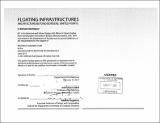Floating infrastructures : architecture beyond borders : united points
Author(s)
Karimipour, Behnam
DownloadFull printable version (36.10Mb)
Alternative title
Architecture beyond borders : united points
Other Contributors
Massachusetts Institute of Technology. Department of Architecture.
Advisor
Antón García Abril and Maria Alessandra Segantini.
Terms of use
Metadata
Show full item recordAbstract
A border could be a physical obstacle but beyond it physicality-it could also impact culture, politics, economic and environment. Our issues that we are facing today and in the near future requires us to draw a new non geopolitical map without borders for our planet to address our challenges more effectively. Being adoptable and flexible is one of the solutions or at least a condition where we could discuss and resolve differences. This project on its path is criticizing UN's inflexible Architecture; it's Urbanity and argues that the function, form and place could impact the decision making process. To have this concept more appealing to nations to participate in its creation we need environments where no nation has authority over them. International Water is that environment for this Utopian idea as a place for civic and political exchange free from existing conventional authorities existed in the world and only 12 NM away form shore lines. Water would give this dense city type environments in dependency from land and nation's jurisdictions and allow more nations to join its cause eventually. Also, With more body of water on our planet today more than ever it seems logical to study a place for refuge where we could live and grow. Refugees are rising due to increase in conflicts and environmental issues worldwide today more than ever. Millions got displaced and countries and organizations are not able to coop with the scale of the issues on their own. The Floating infrastructure is the place for humanity purposes. This place is designed to be able to sustain itself by creating its own energy, food nd desalination systems to make a living condition possible. Floating concrete infrastructures seems viable, due to the advancement in concrete research and technology almost all around the world. Infrastructures that can move and expand to create metabolic forms of function as autonomous forms for many years, sustainable and independent form the land, is what this project is trying to investigate.
Description
Thesis (M. Arch.)--Massachusetts Institute of Technology, Dept. of Architecture, 2013. Page 82 blank. Cataloged from PDF version of thesis. Includes bibliographical references (p. 79).
Date issued
2013Department
Massachusetts Institute of Technology. Department of ArchitecturePublisher
Massachusetts Institute of Technology
Keywords
Architecture.